证据推理理论(Introduction to Evidential Reasoning)
- 格式:ppt
- 大小:564.50 KB
- 文档页数:12
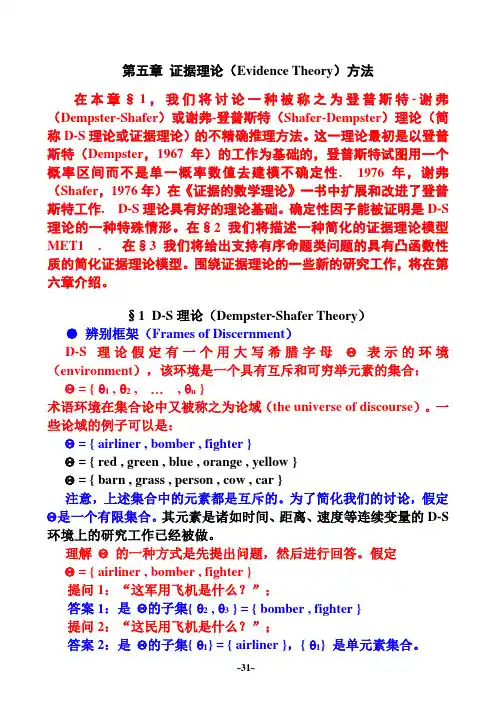
第五章证据理论(Evidence Theory)方法在本章§1,我们将讨论一种被称之为登普斯特-谢弗(Dempster-Shafer)或谢弗-登普斯特(Shafer-Dempster)理论(简称D-S理论或证据理论)的不精确推理方法。
这一理论最初是以登普斯特(Dempster,1967年)的工作为基础的,登普斯特试图用一个概率区间而不是单一概率数值去建模不确定性. 1976年,谢弗(Shafer,1976年)在《证据的数学理论》一书中扩展和改进了登普斯特工作. D-S理论具有好的理论基础。
确定性因子能被证明是D-S 理论的一种特殊情形。
在§2我们将描述一种简化的证据理论模型MET1 . 在§3我们将给出支持有序命题类问题的具有凸函数性质的简化证据理论模型。
围绕证据理论的一些新的研究工作,将在第六章介绍。
§1D-S理论(Dempster-Shafer Theory)●辨别框架(Frames of Discernment)D-S理论假定有一个用大写希腊字母Θ表示的环境(environment),该环境是一个具有互斥和可穷举元素的集合:Θ = { θ1 , θ2 , ⋯, θn }术语环境在集合论中又被称之为论域(the universe of discourse)。
一些论域的例子可以是:Θ = { airliner , bomber , fighter }Θ = { red , green , blue , orange , yellow }Θ = { barn , grass , person , cow , car }注意,上述集合中的元素都是互斥的。
为了简化我们的讨论,假定Θ是一个有限集合。
其元素是诸如时间、距离、速度等连续变量的D-S 环境上的研究工作已经被做。
理解Θ的一种方式是先提出问题,然后进行回答。
假定Θ = { airliner , bomber , fighter }提问1:“这军用飞机是什么?”;答案1:是Θ的子集{ θ2 , θ3 } = { bomber , fighter }提问2:“这民用飞机是什么?”;答案2:是Θ的子集{ θ1} = { airliner },{ θ1} 是单元素集合。
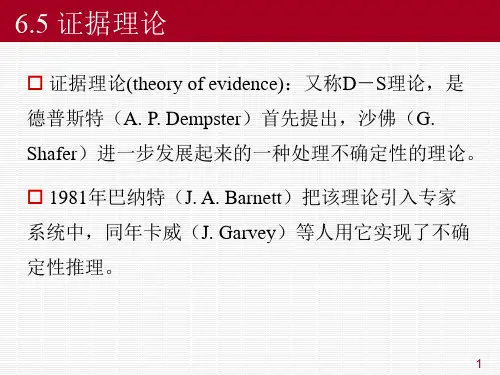
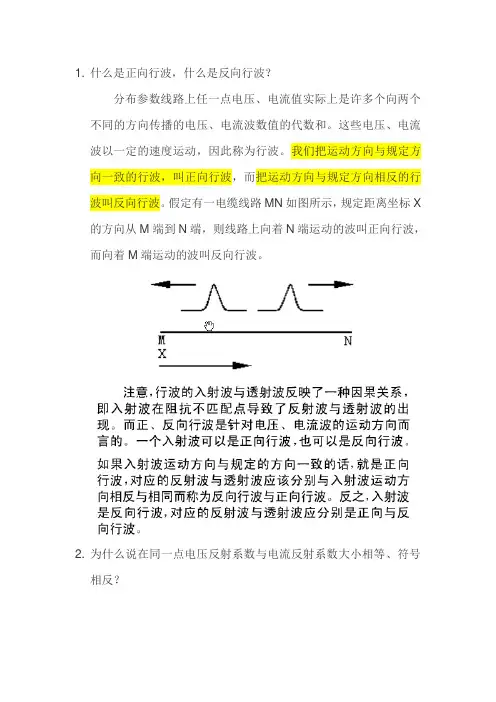
1.什么是正向行波,什么是反向行波?分布参数线路上任一点电压、电流值实际上是许多个向两个不同的方向传播的电压、电流波数值的代数和。
这些电压、电流波以一定的速度运动,因此称为行波。
我们把运动方向与规定方向一致的行波,叫正向行波,而把运动方向与规定方向相反的行波叫反向行波。
假定有一电缆线路MN如图所示,规定距离坐标X 的方向从M端到N端,则线路上向着N端运动的波叫正向行波,而向着M端运动的波叫反向行波。
2.为什么说在同一点电压反射系数与电流反射系数大小相等、符号相反?3.行波中的零模分量和线模分量是什么?有什么区别?4.小波变换?特别是二进制小波变换?5.何为对端母线?对端负载?6.暂态电流形成的反向行波浪涌与其对应的正向行波浪涌的极性?7.利用直流高压或脉冲高压信号的作用把电缆故障点击穿?把故障点击穿是什么意思?8.冲闪测试是什么?以“冲闪法”为原理的电缆故障测试仪,实际应当叫“高压电缆的高阻故障测试仪”,它对高压电缆的高阻闪络及高阻泄露故障解决起来非常适合,而且目前也只有此种方式可以解决,这是因为此类故障一般在电缆的外皮看不出有什么痕迹,只有用“冲闪法”迫使故障点放电,才能测出故障点距离,击穿电缆外皮使故障点表露出来,才能确定故障点的准确位置。
9.线性电流耦合器?10.高速采集技术?11.高阻故障是什么?12.什么是奇异信号?在信号系统分析中,经常要遇到函数本身有不连续点或其导数与积分有不连续点的情况,这类函数称为奇异函数或奇异信号。
奇异性实际上是衡量信号在各尺度上某一点或某一区间在各个尺度的衰减程度。
可以用如下公式求解:abs(wf(u,s))<=A*s*exp (a+1/2)来求解。
u是时移,s是尺度,u在区间[a,b]上,公式中的a就是lipschitz指数,这是区间上的一致性,当然还有点态lipschtiz 指数,仅供参考。
奇异信号可分为斜变信号、阶跃信号(最重要)、冲激信号(最重要)、冲激偶信号。
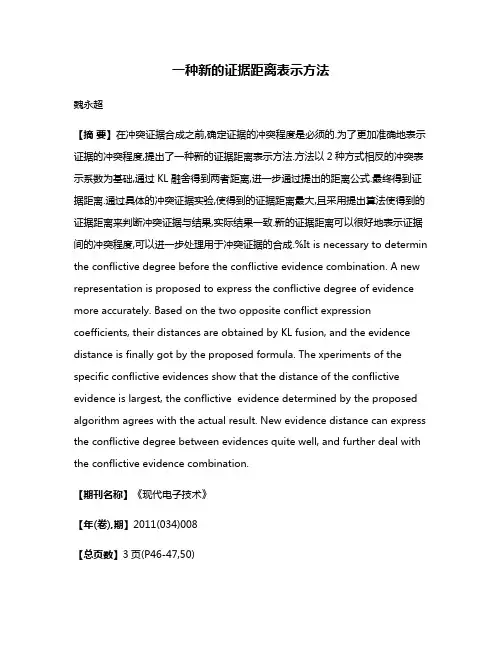
一种新的证据距离表示方法魏永超【摘要】在冲突证据合成之前,确定证据的冲突程度是必须的.为了更加准确地表示证据的冲突程度,提出了一种新的证据距离表示方法.方法以2种方式相反的冲突表示系数为基础,通过KL融舍得到两者距离,进一步通过提出的距离公式.最终得到证据距离.通过具体的冲突证据实验,使得到的证据距离最大,且采用提出算法使得到的证据距离来判断冲突证据与结果,实际结果一致.新的证据距离可以很好地表示证据间的冲突程度,可以进一步处理用于冲突证据的合成.%It is necessary to determin the conflictive degree before the conflictive evidence combination. A new representation is proposed to express the conflictive degree of evidence more accurately. Based on the two opposite conflict expression coefficients, their distances are obtained by KL fusion, and the evidence distance is finally got by the proposed formula. The xperiments of the specific conflictive evidences show that the distance of the conflictive evidence is largest, the conflictive evidence determined by the proposed algorithm agrees with the actual result. New evidence distance can express the conflictive degree between evidences quite well, and further deal with the conflictive evidence combination.【期刊名称】《现代电子技术》【年(卷),期】2011(034)008【总页数】3页(P46-47,50)【关键词】信息融合;证据合成;冲突;证据距离【作者】魏永超【作者单位】中国民用航空飞行学院,飞行技术与飞行安全科研基地,四川,广汉,618307【正文语种】中文【中图分类】TN91-340 引言D-S理论是Dempster和Shafer共同创立的一种不确定性推理理论,由于它对不确定信息的表达和合成提供了自然而强有力的方法,因此在信息融合中获得了广泛的应用[1-3]。
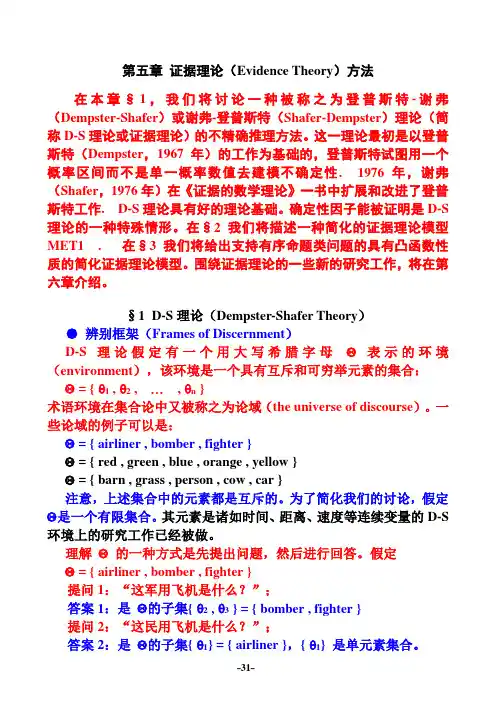
第五章证据理论(Evidence Theory)方法在本章§1,我们将讨论一种被称之为登普斯特-谢弗(Dempster-Shafer)或谢弗-登普斯特(Shafer-Dempster)理论(简称D-S理论或证据理论)的不精确推理方法。
这一理论最初是以登普斯特(Dempster,1967年)的工作为基础的,登普斯特试图用一个概率区间而不是单一概率数值去建模不确定性. 1976年,谢弗(Shafer,1976年)在《证据的数学理论》一书中扩展和改进了登普斯特工作. D-S理论具有好的理论基础。
确定性因子能被证明是D-S 理论的一种特殊情形。
在§2我们将描述一种简化的证据理论模型MET1 . 在§3我们将给出支持有序命题类问题的具有凸函数性质的简化证据理论模型。
围绕证据理论的一些新的研究工作,将在第六章介绍。
§1D-S理论(Dempster-Shafer Theory)●辨别框架(Frames of Discernment)D-S理论假定有一个用大写希腊字母Θ表示的环境(environment),该环境是一个具有互斥和可穷举元素的集合:Θ = { θ1 , θ2 , ⋯, θn }术语环境在集合论中又被称之为论域(the universe of discourse)。
一些论域的例子可以是:Θ = { airliner , bomber , fighter }Θ = { red , green , blue , orange , yellow }Θ = { barn , grass , person , cow , car }注意,上述集合中的元素都是互斥的。
为了简化我们的讨论,假定Θ是一个有限集合。
其元素是诸如时间、距离、速度等连续变量的D-S 环境上的研究工作已经被做。
理解Θ的一种方式是先提出问题,然后进行回答。
假定Θ = { airliner , bomber , fighter }提问1:“这军用飞机是什么?”;答案1:是Θ的子集{ θ2 , θ3 } = { bomber , fighter }提问2:“这民用飞机是什么?”;答案2:是Θ的子集{ θ1} = { airliner },{ θ1} 是单元素集合。
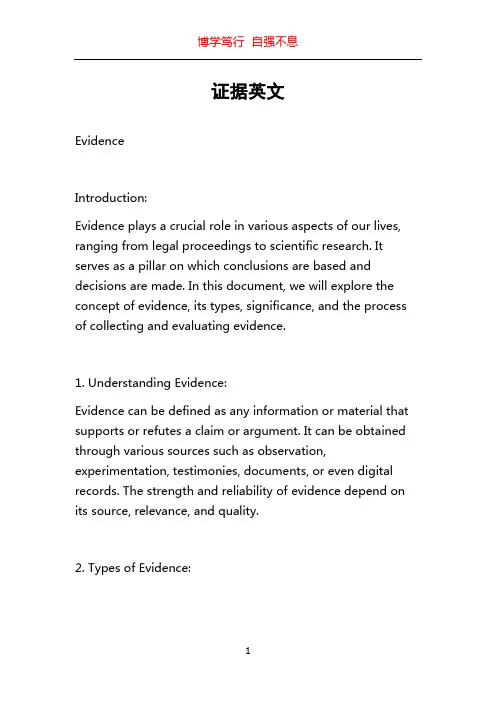
证据英文EvidenceIntroduction:Evidence plays a crucial role in various aspects of our lives, ranging from legal proceedings to scientific research. It serves as a pillar on which conclusions are based and decisions are made. In this document, we will explore the concept of evidence, its types, significance, and the process of collecting and evaluating evidence.1. Understanding Evidence:Evidence can be defined as any information or material that supports or refutes a claim or argument. It can be obtained through various sources such as observation, experimentation, testimonies, documents, or even digital records. The strength and reliability of evidence depend on its source, relevance, and quality.2. Types of Evidence:a) Direct Evidence: This type of evidence directly proves or disproves a fact or claim. For example, eyewitness testimonies, surveillance footage, or DNA analysis.b) Circumstantial Evidence: Unlike direct evidence, circumstantial evidence does not directly prove a claim but can be inferred to support it. It relies on the logical connection between the evidence and the conclusion. For instance, finding a suspect's fingerprints at a crime scene.c) Documentary Evidence: This category includes written or recorded evidence, such as contracts, emails, diaries, photographs, or official documents. It serves as a primary source of evidence in legal cases or historical research.d) Digital Evidence: With technology becoming increasingly prevalent, digital evidence has gained importance. It includes digital records, computer files, social media posts, or electronic communications.3. The Significance of Evidence:a) Establishing Truth: Evidence is crucial for establishing the truth or accuracy of a claim. It provides the necessary support to validate or reject a hypothesis or statement.b) Influencing Decision-Making: Evidence plays a vital role in influencing decisions made by individuals, organizations, or even governing bodies. It helps in determining guilt or innocence in legal cases or forming policies based on scientific research.c) Ensuring Fairness: Evidence ensures fairness in legal proceedings by providing an objective basis for judgments. It helps in avoiding bias or subjective decision-making.4. Collecting and Evaluating Evidence:a) Identification: The first step in the process is identifying relevant evidence. This involves determining which type of evidence is necessary and where it can be found.b) Collection: Once identified, evidence needs to be collected using appropriate techniques. This may involve maintaining a proper chain of custody, ensuring the integrity and admissibility of the evidence.c) Preservation: Proper preservation of evidence is crucial to avoid tampering or contamination. This includes storingevidence in controlled environments and adopting best practices to prevent degradation.d) Evaluation: After collecting the evidence, it needs to be carefully evaluated for its relevance, reliability, and credibility. Various methods such as expert analysis or scientific testing can be employed to assess the evidentiary value.e) Presentation: Finally, evidence is presented in a coherent and organized manner to effectively communicate its significance. In legal proceedings, this may include witness testimonies, exhibits, or expert reports.Conclusion:In conclusion, evidence plays a vital role in various aspects of our lives, be it law, science, or everyday decision-making. Understanding the types, significance, and the process of collecting and evaluating evidence is essential for making informed judgments and reaching accurate conclusions. It serves as a foundation for truth-seeking, fairness, and the pursuit of justice in society.。
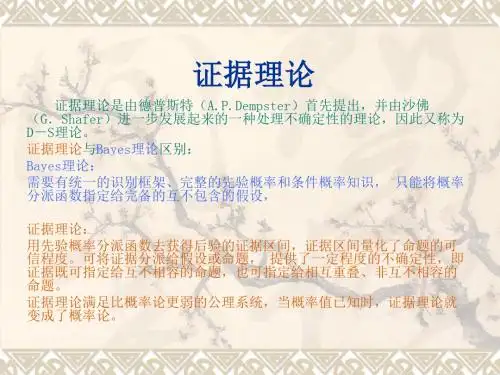
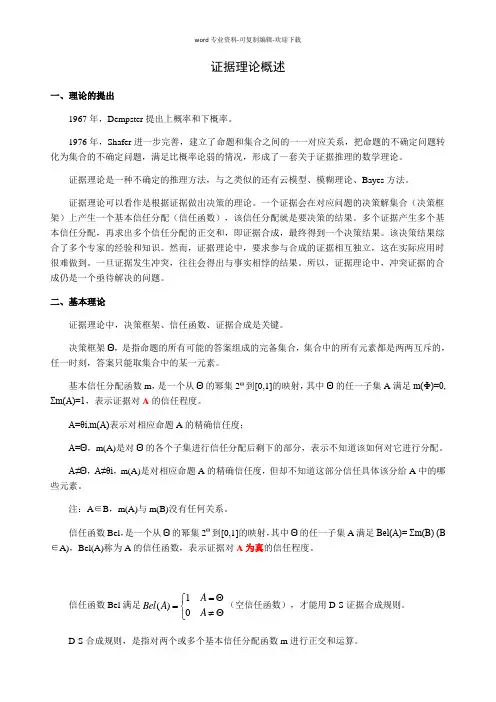
证据理论概述一、理论的提出1967年,Dempster提出上概率和下概率。
1976年,Shafer进一步完善,建立了命题和集合之间的一一对应关系,把命题的不确定问题转化为集合的不确定问题,满足比概率论弱的情况,形成了一套关于证据推理的数学理论。
证据理论是一种不确定的推理方法,与之类似的还有云模型、模糊理论、Bayes方法。
证据理论可以看作是根据证据做出决策的理论。
一个证据会在对应问题的决策解集合(决策框架)上产生一个基本信任分配(信任函数),该信任分配就是要决策的结果。
多个证据产生多个基本信任分配,再求出多个信任分配的正交和,即证据合成,最终得到一个决策结果。
该决策结果综合了多个专家的经验和知识。
然而,证据理论中,要求参与合成的证据相互独立,这在实际应用时很难做到。
一旦证据发生冲突,往往会得出与事实相悖的结果。
所以,证据理论中,冲突证据的合成仍是一个亟待解决的问题。
二、基本理论证据理论中,决策框架、信任函数、证据合成是关键。
决策框架Θ,是指命题的所有可能的答案组成的完备集合,集合中的所有元素都是两两互斥的,任一时刻,答案只能取集合中的某一元素。
基本信任分配函数m,是一个从Θ的幂集2Θ到[0,1]的映射,其中Θ的任一子集A满足m(Ф)=0, Σm(A)=1,表示证据对A的信任程度。
A=θi,m(A)表示对相应命题A的精确信任度;A=Θ,m(A)是对Θ的各个子集进行信任分配后剩下的部分,表示不知道该如何对它进行分配。
A≠Θ,A≠θi,m(A)是对相应命题A的精确信任度,但却不知道这部分信任具体该分给A中的哪些元素。
注:A∈B,m(A)与m(B)没有任何关系。
信任函数Bel,是一个从Θ的幂集2Θ到[0,1]的映射,其中Θ的任一子集A满足Bel(A)= Σm(B) (B ∈A),Bel(A)称为A的信任函数,表示证据对A为真的信任程度。
信任函数Bel满足1()ABel AA=Θ⎧=⎨≠Θ⎩(空信任函数),才能用D-S证据合成规则。
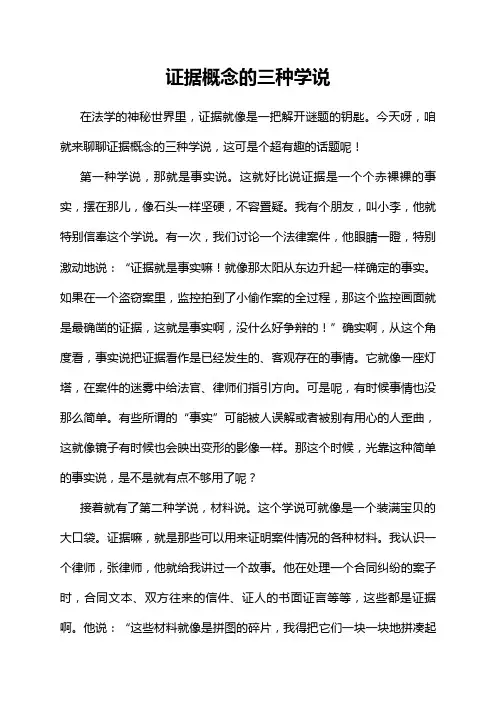
证据概念的三种学说在法学的神秘世界里,证据就像是一把解开谜题的钥匙。
今天呀,咱就来聊聊证据概念的三种学说,这可是个超有趣的话题呢!第一种学说,那就是事实说。
这就好比说证据是一个个赤裸裸的事实,摆在那儿,像石头一样坚硬,不容置疑。
我有个朋友,叫小李,他就特别信奉这个学说。
有一次,我们讨论一个法律案件,他眼睛一瞪,特别激动地说:“证据就是事实嘛!就像那太阳从东边升起一样确定的事实。
如果在一个盗窃案里,监控拍到了小偷作案的全过程,那这个监控画面就是最确凿的证据,这就是事实啊,没什么好争辩的!”确实啊,从这个角度看,事实说把证据看作是已经发生的、客观存在的事情。
它就像一座灯塔,在案件的迷雾中给法官、律师们指引方向。
可是呢,有时候事情也没那么简单。
有些所谓的“事实”可能被人误解或者被别有用心的人歪曲,这就像镜子有时候也会映出变形的影像一样。
那这个时候,光靠这种简单的事实说,是不是就有点不够用了呢?接着就有了第二种学说,材料说。
这个学说可就像是一个装满宝贝的大口袋。
证据嘛,就是那些可以用来证明案件情况的各种材料。
我认识一个律师,张律师,他就给我讲过一个故事。
他在处理一个合同纠纷的案子时,合同文本、双方往来的信件、证人的书面证言等等,这些都是证据啊。
他说:“这些材料就像是拼图的碎片,我得把它们一块一块地拼凑起来,才能还原案件的全貌。
”材料说的好处是它把证据的范围扩大了,不再局限于单纯的事实。
它就像一个大杂烩,各种各样的东西都可以装进来。
但是呢,这也有个问题。
这么多材料,哪些才是真正有用的,哪些可能是误导人的呢?这就像在一堆沙子里找金子一样,得费好大的功夫去筛选。
最后就是一种比较新的学说,根据说。
这个学说可有点像一个指南针。
它认为证据是一种根据,是我们用来推断案件事实的依据。
我的大学同学小王,他对这个学说特别感兴趣。
他说:“你想啊,在一个复杂的刑事案件里,可能没有直接的事实或者完整的材料。
比如说,在一个没有监控,也没有目击证人的杀人案中,现场发现的一些毛发、血迹,这些东西本身不是事实,也不是简单的材料,而是我们推断凶手是谁、怎么作案的根据。
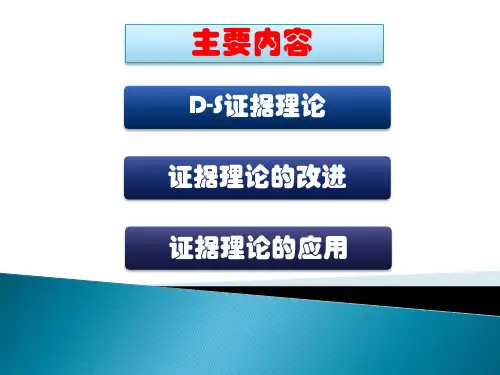
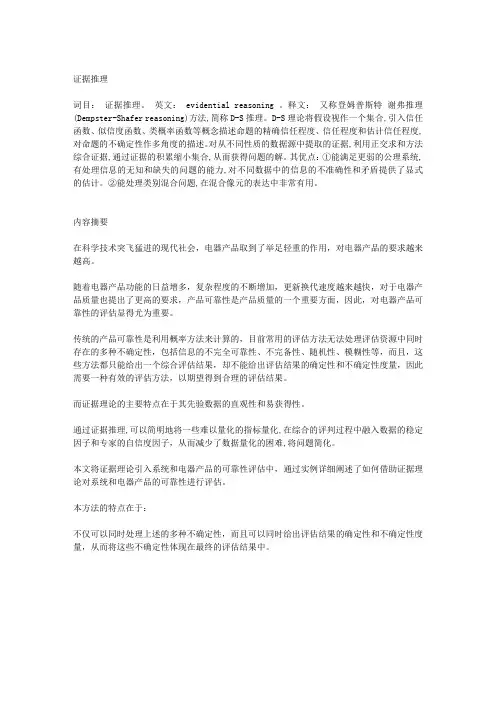
证据推理词目:证据推理。
英文: evidential reasoning 。
释文:又称登姆普斯特谢弗推理(Dempster-Shafer reasoning)方法,简称D-S推理。
D-S理论将假设视作一个集合,引入信任函数、似信度函数、类概率函数等概念描述命题的精确信任程度、信任程度和估计信任程度,对命题的不确定性作多角度的描述。
对从不同性质的数据源中提取的证据,利用正交求和方法综合证据,通过证据的积累缩小集合,从而获得问题的解。
其优点:①能满足更弱的公理系统,有处理信息的无知和缺失的问题的能力,对不同数据中的信息的不准确性和矛盾提供了显式的估计。
②能处理类别混合问题,在混合像元的表达中非常有用。
内容摘要在科学技术突飞猛进的现代社会,电器产品取到了举足轻重的作用,对电器产品的要求越来越高。
随着电器产品功能的日益增多,复杂程度的不断增加,更新换代速度越来越快,对于电器产品质量也提出了更高的要求,产品可靠性是产品质量的一个重要方面,因此,对电器产品可靠性的评估显得尤为重要。
传统的产品可靠性是利用概率方法来计算的,目前常用的评估方法无法处理评估资源中同时存在的多种不确定性,包括信息的不完全可靠性、不完备性、随机性、模糊性等,而且,这些方法都只能给出一个综合评估结果,却不能给出评估结果的确定性和不确定性度量,因此需要一种有效的评估方法,以期望得到合理的评估结果。
而证据理论的主要特点在于其先验数据的直观性和易获得性。
通过证据推理,可以简明地将一些难以量化的指标量化,在综合的评判过程中融入数据的稳定因子和专家的自信度因子,从而减少了数据量化的困难,将问题简化。
本文将证据理论引入系统和电器产品的可靠性评估中,通过实例详细阐述了如何借助证据理论对系统和电器产品的可靠性进行评估。
本方法的特点在于:不仅可以同时处理上述的多种不确定性,而且可以同时给出评估结果的确定性和不确定性度量,从而将这些不确定性体现在最终的评估结果中。
d-s证据理论证据理论是由Dempster于1967年首先提出,由他的学生shafer于1976年进一步发展起来的一种不精确推理理论,也称为Dempster/Shafer 证据理论(D-S证据理论),属于人工智能范畴,最早应用于专家系统中,具有处理不确定信息的能力。
作为一种不确定推理方法,证据理论的主要特点是:满足比贝叶斯概率论更弱的条件;具有直接表达“不确定”和“不知道”的能力.。
在此之后,很多技术将DS 理论进行完善和发展,其中之一就是证据合成(Evidential reasoning, ER) 算法。
ER 算法是在置信评价框架和DS 理论的基础上发展起来的。
ER 算法被成功应用于:机动车评价分析、货船设计、海军系统安全分析与综合、软件系统安全性能分析、改造轮渡设计、行政车辆评估集组织评价。
在医学诊断、目标识别、军事指挥等许多应用领域,需要综合考虑来自多源的不确定信息,如多个传感器的信息、多位专家的意见等等,以完成问题的求解,而证据理论的联合规则在这方面的求解发挥了重要作用。
在DS证据理论中,由互不相容的基本命题(假定)组成的完备集合称为识别框架,表示对某一问题的所有可能答案,但其中只有一个答案是正确的。
该框架的子集称为命题。
分配给各命题的信任程度称为基本概率分配(BPA,也称m函数),m(A)为基本可信数,反映着对A的信度大小。
信任函数Belgium(A)表示对命题A的信任程度,似然函数Pl(A)表示对命题A非假的信任程度,也即对A似乎可能成立的不确定性度量,实际上,[Bel(A),Pl(A)]表示A的不确定区间,[0,Bel(A)]表示命题A支持证据区间,[0,Pl(A)]表示命题A的拟信区间,[Pl(A),1]表示命题A的拒绝证据区间。
设m1和m2是由两个独立的证据源(传感器)导出的基本概率分配函数,则Dempster联合规则可以计算这两个证据共同作用产生的反映融合信息的新的基本概率分配函数。